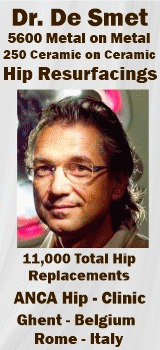The controversy regarding adverse wear in metal-metal bearings
Thomas P. Gross , MD 3/5/2010
I have used over 3000 metal bearings in primary total hip and hip resurfacing as well as revision surgery. I have revised 2 for adverse wear 7 years after implantation. I know that most other high volume hip resurfacing surgeons have a similar experience. The revisions were straightforward and the patient enjoyed the same rapid and complete recovery as if she had a primary hip replacement.
Currently less than 5% of my practice involves revision surgery. However, I have revised over 100 metal plastic replacements for excess wear. Furthermore significant wear related damage to the tissues is seen in virtually all metal plastic hip replacement or knee replacement revised for other causes.
A surgical group that has seen a surprisingly large number of wear‐related failures of metal bearing implants has coined the term “seudotumor”when an inflammatory soft tissue mass is seen around the hip of a metal bearing implant. However, this inflammatory soft tissue reaction to metal wear debris is not much different than the inflammatory reaction that we have seen with plastic wear debris for many years.
All artificial bearing implants give off wear particles. The question is, which type of wear debris is best tolerated by the body? During the last 20 years of joint replacement polyethylene osteolysis (bone destruction caused by plastic wear debris) has been a major problem. But anyone who has revised total joints is also aware that polyethelene debris also is always associated with large amounts of soft tissue reaction around the joint. Polyethelene has been improved, and metal bearings have been developed. Both give off much less wear debris than the old polyethelene implants. The question is which results in less wear related damage? At this point we do not yet have the answer. Adverse wear reaction is a serious problem, but fortunately it is very rare.
Lets put this into perspective. The most common reason resulting in revision of total hip replacements in the US is hip instability (recurrent dislocation). 20% of all hip revisions are done for this reason. This is far more common than adverse wear reaction. Hip instability is a very disabling condition that occurs in 3‐5 % of hip replacements. The rate of instability for large head metal bearings is less than ½%. Larger bearings are the solution for this problem. Large head metal bearings (resurfacing and total hip) are currently the only ones that allow reconstructingthe hip in a biomechanically normal fashion to avoid instability. Proponents of plastic and ceramic bearings realize this and have made their bearings thinner recently to allow larger heads to be inserted (32‐36mm). This has made them more stable, but 32‐36mm does not yet approximate normal femoral head sizes in the average female (48mm) and average male (52mm) patients. These larger head (32‐36mm) implants for plastic and ceramic bearings have only been in use for a few years and it is not yet clear if these bearings will break at a higher rate because they are thinner. I would not recommend impact sports on thin plastic and ceramic bearings. Anatomic sizing that matches the patient’ own size is only possible with large metal head designs. These are stable and can tolerate repetitive full impact without breaking. Wear rates are not significantly increased by running.
In the last few years we have learned that these rare cases of adverse wear in metal bearings are related to three factors: steep acetabular inclination greater than 55 degrees, small component sizes, certain component designs with an extremely shallow arc of coverage. At this point it is still only a very tiny percentage of patients with cup inclination angles above 55 degrees that have had wear problems. If a patient with an inclination angle above 55 degrees develops symptoms years after surgery, I would first check metal levels and an MRI. If the levels were high or a soft tissue mass developed I would recommend revision. So far this has happened twice in my practice.
More important, however, is prevention of this adverse wear complication. Since this information about cup inclination has become available several years ago we developed and tested a protocol for measuring the inclination by XR during the operation. The paper reporting this technique will be published in CORR this year. Using this technique in every case, I now have had no cupsimplanted with inclination greater than 55 degrees since 10/ 2007. We expect that this technique will completely eliminate this rare cause of failure in metal bearing hip implants: adverse wear reaction.










